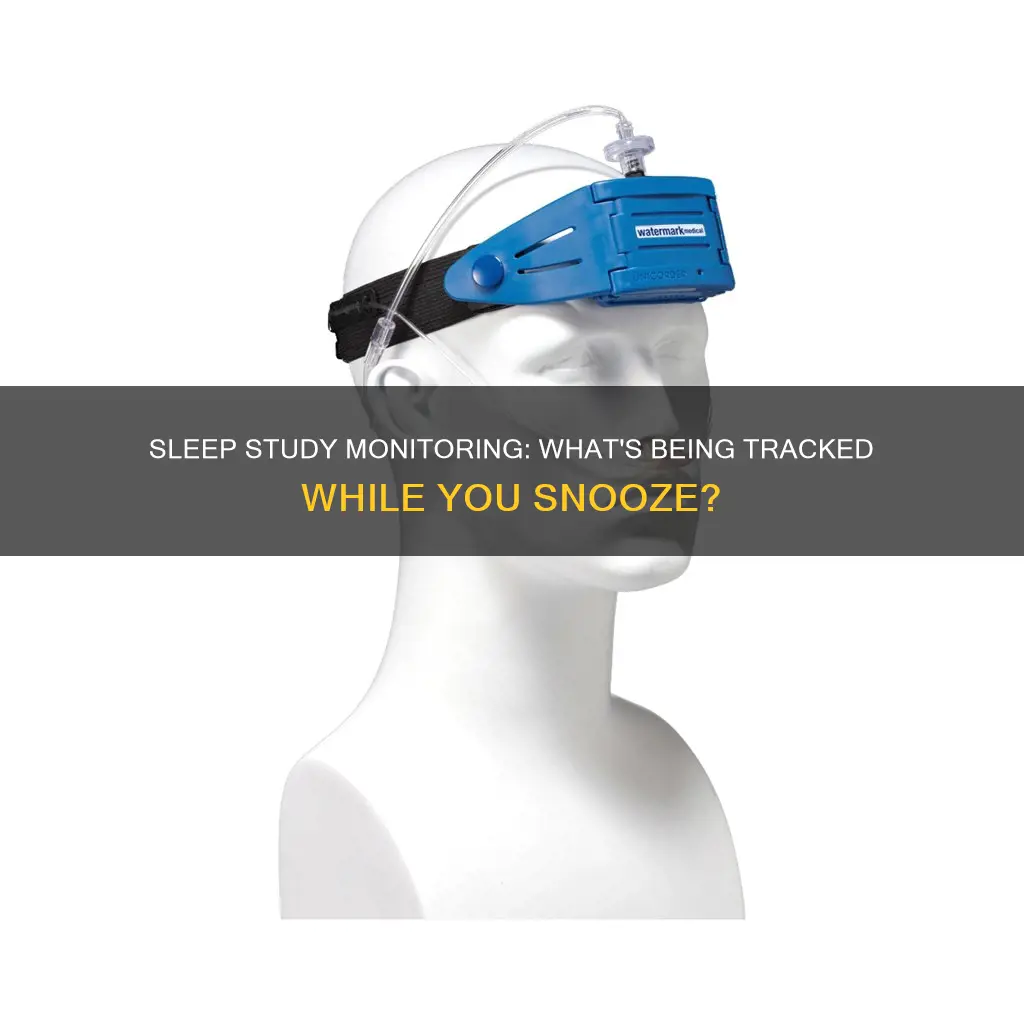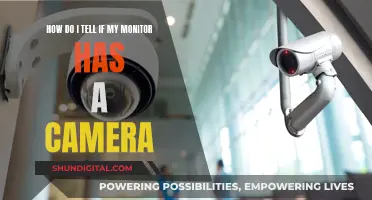
Sleep studies, formally known as polysomnography, are diagnostic tests that monitor and record the activity of multiple body systems, including the heart, brain, and respiratory system, to provide healthcare providers with a comprehensive view of the quality of an individual's sleep. These tests are typically conducted overnight in a sleep lab or clinic, where medical technicians, technologists, assistants, and nurses attach sensors to the patient's body to track various physiological parameters. The data collected during a sleep study helps in diagnosing and treating sleep disorders such as sleep apnea, restless leg syndrome, and other conditions that affect sleep quality.
| Characteristics | Values |
|---|---|
| Brain Activity | Brain waves, sleep stages |
| Heart Activity | Heart rate, rhythm, electrical activity |
| Eye Movement | Eye movement, rolling, jerking |
| Breathing | Airflow, oxygen levels, respiratory rate, pauses in breathing |
| Muscle Activity | Muscle movement, muscle tone |
| Body Movement | Body position, leg movement |
| Sleep Quality | Sleep duration, interruptions, sleep phases |
| Environmental Factors | Light, temperature |
What You'll Learn

Brain activity
Sleep studies are a diagnostic test that involves recording multiple systems in the body while the patient sleeps. One of the key body systems monitored is brain activity. Brain activity is measured through electroencephalography (EEG) sensors, which are coated in a sticky, electrically conductive gel that helps them adhere to the patient's head. These sensors detect and record the electrical activity of the brain, known as brain waves, while the patient is asleep. Different types of brain waves occur during different stages of sleep, and this is a key way to identify sleep disorders and issues.
EEG sensors are typically attached to the scalp close to the top, back, and frontal areas of the brain. The channels from these sensors are used to identify whether a patient is awake or asleep, and the different stages of sleep they progress through. The different stages of sleep include light sleep, deep sleep, and REM sleep, each of which is linked to specific brain waves and neuronal activity. During REM sleep, for example, mixed-frequency brain wave activity becomes closer to that seen in wakefulness, and dreaming occurs.
The data collected from EEG sensors during a sleep study can help sleep specialists determine if a patient is reaching and progressing through the various sleep stages as expected. Results from these tests may be used to develop a treatment plan or determine if further tests are needed.
Monitoring SLA Performance: Strategies for Success
You may want to see also

Eye movement
The Electro-oculography (EOG) test is a crucial component of a sleep study, involving the placement of adhesive sensors around the subject's eyes to monitor eye activity during sleep. This is particularly important for understanding the nature of dreams and the imaginative capabilities of the brain.
The rapid eye movement (REM) phase of sleep, characterised by random rapid movement of the eyes, is associated with vivid dreams and low muscle tone throughout the body. While the purpose of eye movement during REM sleep has long been a mystery, recent studies on mice suggest that these movements are not random but are coordinated with the content of dreams.
During REM sleep, the eyes move in tandem, following ponto-geniculo-occipital (PGO) waves originating in the brain stem. These PGO waves cause the rapid eye movements and may be linked to the sense of vision experienced in dreams. However, the relationship between eye movements and dream content remains unclear, as congenitally blind people who do not have visual imagery in their dreams still exhibit eye movements during REM sleep.
The direction and amplitude of eye movements during REM sleep can be predicted by assessing the activity of head direction cells, which act as a compass indicating which direction the subject perceives itself as heading. Researchers have found that the direction of eye movements and the internal compass of the subject are precisely aligned during REM sleep, similar to when the subject is awake and moving around.
These findings shed light on how our imaginations work and how we dream, suggesting that the brain conjures up wholly imagined worlds during sleep.
Salvaging a Broken LCD Monitor: Creative Solutions and Ideas
You may want to see also

Heart rate
Sleep study monitors can be used to track heart rate, which is the number of times your heart beats per minute. These devices can be valuable tools for monitoring your health, but they are not as accurate as approved medical devices and should not be used as a substitute for medical care.
There are two main types of heart rate monitors: electrical (electrocardiography) and optical (photoplethysmography). Electrical devices detect the small electrical current generated by your heart with each heartbeat. Optical devices use infrared light to see the expansion of your arteries as your heart pumps blood through them. Some optical devices can also estimate blood oxygen levels.
Sleep study monitors that track heart rate can provide insights into your sleep quality and help identify sleep problems. They can detect changes in your heart rate during sleep, which can indicate the different sleep cycles you go through. However, it is important to note that these devices may not always accurately differentiate between sleep stages and should not be solely relied upon for medical diagnoses.
What Monitor Do You Have? Identifying an AUO Screen
You may want to see also

Breathing patterns
Sleep studies monitor breathing patterns to detect and diagnose sleep-related conditions, such as sleep apnea, periodic limb movement disorder, and sleepwalking. Breathing patterns are tracked using various sensors and monitoring methods, including breathing sensors, respiratory inductive plethysmography (RIP) belts, and pulse oximeters.
Breathing sensors are used to detect air movement through the mouth and nose, providing data on breathing patterns during sleep. These sensors are typically placed near the nose and mouth to capture any changes in air movement.
Respiratory inductive plethysmography (RIP) belts are devices that detect the expansion and contraction of the torso during breathing. These belts are placed around the chest and belly to measure the rise and fall of the chest cavity, providing information about the depth and rhythm of breaths.
Pulse oximeters are small adhesive sensors placed on the tip of a finger to measure pulse rate and blood oxygen levels. This data helps assess the quality of breathing during sleep and can indicate any disruptions or abnormalities.
Additionally, video and audio monitoring are used to observe and record the sleeper's breathing patterns. This allows sleep specialists to visually and audibly assess breathing patterns, synchronizing the recordings with sensor data to gain a comprehensive understanding of the sleeper's respiratory behaviour during sleep.
By combining data from breathing sensors, RIP belts, pulse oximeters, and audio-visual recordings, sleep specialists can identify breathing abnormalities, such as pauses or interruptions in breathing, shallow or deep breathing, and variations in breathing effort. This information is crucial for diagnosing and treating sleep-related breathing disorders, ensuring better sleep quality and overall health.
Oprah's Ankle Monitor: Fact or Fiction?
You may want to see also

Body movement
Sleep studies monitor body movement in a variety of ways, depending on the type of study and the equipment used. One of the most common methods is through the use of sensors attached to the skin, known as electromyography (EMG). These sensors are typically placed on the face and a leg to track muscle movement during sleep. Unlike standard EMGs used for diagnostic purposes, the sensors used in sleep studies are for monitoring only and do not activate any muscles.
Another way to monitor body movement during a sleep study is through video and audio monitoring. This method allows staff to observe and record the patient's movements and behaviours during sleep. This can be particularly useful if any unusual or concerning readings are detected through other monitoring methods, such as sensors. Additionally, the recordings can be synchronised with sensor data to provide a comprehensive understanding of the patient's sleep patterns and behaviours.
Some sleep studies may also employ the use of wearable devices, such as smartwatches, rings, or headbands, which can track body movement in addition to other sleep parameters. These devices often contain motion-sensing technology, such as accelerometers or inertial measurement units (IMUs), which can detect and record the wearer's movements during sleep. These devices can provide valuable insights into sleep patterns and quality, and some even offer tips and advice for improving sleep habits based on the data collected.
In the case of at-home sleep tests, body movement may be monitored through sensors placed on the abdomen and chest, which measure the rise and fall of the chest and abdomen during breathing. These sensors can help detect any disruptions or abnormalities in breathing patterns, which may be indicative of sleep disorders such as sleep apnea.
Overall, the monitoring of body movement during sleep studies is crucial for understanding the quality of sleep and diagnosing various sleep disorders, such as periodic limb movement disorder or restless legs syndrome. By tracking body movement in conjunction with other physiological parameters, healthcare providers can gain a comprehensive understanding of an individual's sleep patterns and make informed diagnoses and treatment plans.
Cutting Off Ankle Tags: A Step-by-Step Guide
You may want to see also
Frequently asked questions
Sleep studies monitor various body functions to help diagnose sleep disorders. This includes brain activity, eye movement, heart rate, breathing patterns, oxygen levels in the blood, body movements, and snoring.
Sleep studies typically take place during an overnight stay at a sleep lab or hospital. Most people only need to stay for one night, but in some cases, more nights may be required.
During a sleep study, electrodes and sensors are attached to your body to monitor your brain waves, heart rate, breathing, and other body functions. You will be asked to perform simple tasks to calibrate the sensors, and then you can relax and sleep as usual.
If you are experiencing sleep issues such as trouble falling asleep, frequent waking, snoring, or other symptoms of sleep disorders, your healthcare provider may recommend a sleep study. Sleep studies are particularly useful for diagnosing sleep disorders such as sleep apnea, restless leg syndrome, and insomnia.







